Jupiter Image List
The Planet Jupiter

This is a color-enhanced image of Jupiter taken by Voyager 1. (Courtesy of NASA)
(39K JPG)

These are two images of Jupiter. The first is infrared and the second is a visible image. Both were taken in 1979. (Courtesy of NASA)
(23K JPG)
Family Portraits of Jupiter and its Moons

This is a three-color image of Jupiter and Ganymede taken by Voyager 1. (Courtesy of NASA)
(60K JPG)
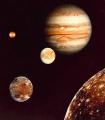
This is an image of jupiter and its four moons, the Galilean satellites photographed by Voyager 1. They are not to scale, but in their correct positions. (Courtesy of NASA)
(77K JPG)

This is a three-color filter image of Jupiter and Io. It was taken on June 10, 1979 by Voyager 2. (Courtesy of NASA)
(60K JPG)
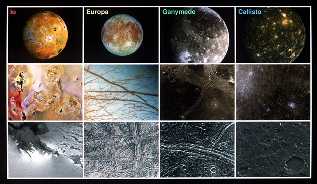
This is a collage of the Galilean satellites taken by Galileo spacecraft. (Courtesy of NASA)
(60K JPG)
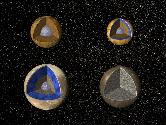
This drawing shows the possible interiors of the Galilean moons. (Courtesy of JPL)
(60K JPG)
Small Moons of Jupiter

This is a three-color filter image of Amalthea, Jupiter's innermost satellite taken by Voyager 1. It speeds around Jupiter every 12 hours.(Courtesy of NASA)
(8K JPG)

This is a morphographic conformal projection of Amalthea
(79K GIF)
The Galilean Moons
Io
It is of Io Plasma Torus Click Here
This is of Io rotating Click Here

This is an image of Io. It is the innermost of the Galilean moons and the third largest. (Courtesy of NASA)
(39K JPG)

Another image of Io. It is slightly larger than the Earth's moon. (Courtesy of NASA)
(198K GIF)
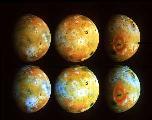
6 views of Io, taken by the Galileo spacecraft. (Courtesy of NASA)
(69K JPG)
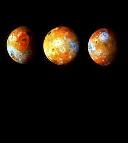
3 views of Io, taken by the Galileo spacecraft. The image shows some frost on the surface. (Courtesy of NASA)
(49K GIF)

This is an image of Io's surface taken by Galileo. (Courtesy of NASA)
(350K GIF)

This is an image of Io's surface taken by Voyager. (Courtesy of NASA)
(159K GIF)

This is an image of Io's volcanic plain taken by Voyager. (Courtesy of
NASA)
(26K JPEG)
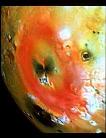
Pele, taken by the Galileo spacecraft. (Courtesy of NASA)
(45K JPG)
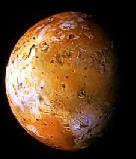
Io, taken by the Galileo spacecraft. (Courtesy of NASA)
(45K JPG)

Io, taken by the Galileo spacecraft. (Courtesy of NASA)
(45K JPG)
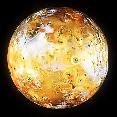
Io, taken by the Galileo spacecraft. (Courtesy of NASA)
(45K JPG)
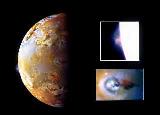
Io, taken by the Galileo spacecraft. (Courtesy of NASA)
(45K JPG)
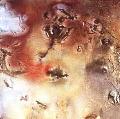
Io, taken by the Galileo spacecraft. (Courtesy of NASA)
(45K JPG)

Io, taken by the Galileo spacecraft. (Courtesy of NASA)
(45K JPG)
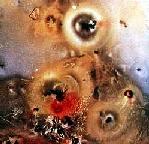
Io, taken by the Galileo spacecraft. (Courtesy of NASA)
(45K JPG)
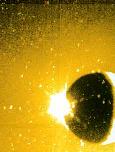
Io in eclipse, taken by the Galileo spacecraft. (Courtesy of NASA)
(45K JPG)

Io in eclipse, taken by the Galileo spacecraft. (Courtesy of NASA)
(42K JPG)

This drawing shows the possible interior of Io. (Courtesy of JPL)
(60K JPG)
Europa
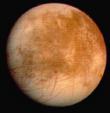
This is a three-color image of the satellite Europa taken March 4, 1979 by Voyager 1. It is the size of Earth's moon. (Courtesy of NASA)
(28K JPG)

This is a close-up image of Europa taken by Voyager 2 on July 9,1979. (Courtesy of NASA)
(134K JPG)

This is an image of the Europa taken by Voyager. (Courtesy of NASA)
(56K JPG)

This is a close-up image of the Europa taken by Voyager. (Courtesy of NASA)
(56K JPG)
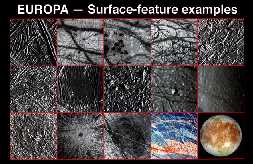
This is a Europa collage taken by the Galileo spacecraft. (Courtesy of NASA)
(56K JPG)
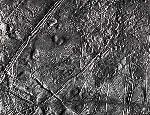
This is a Europa collage taken by the Galileo spacecraft. (Courtesy of NASA)
(56K JPG)

This is a close-up image of the Pwyll crater taken by the Galileo spacecraft. (Courtesy of NASA)
(56K JPG)

This is a close-up image of Europa in false color taken by the Galileo spacecraft. (Courtesy of NASA)
(56K JPG)

This is a close-up image of Europa in false color taken by the Galileo spacecraft. (Courtesy of NASA)
(56K JPG)

This is an image of Europa global linea taken by the Galileo spacecraft showing "pull-apart" features. (Courtesy of NASA)
(56K JPG)

This is an image of Europa Conamura chaos region taken by the Galileo spacecraft. (Courtesy of NASA)
(56K JPG)

This is an image of Europa taken by the Galileo spacecraft. (Courtesy of NASA)
(56K JPG)
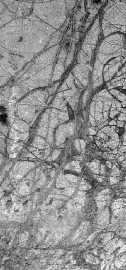
This is an image of Europa taken by the Galileo spacecraft. (Courtesy of NASA)
(56K JPG)
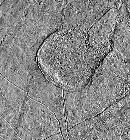
This is an image of lobate or "puddle-like" flows of Europa taken by the Galileo spacecraft. (Courtesy of NASA)
(56K JPG)

This is an image of Europa linea taken by the Galileo spacecraft. (Courtesy of NASA)
(56K JPG)

This is an image of Europa taken by the Galileo spacecraft. (Courtesy of NASA)
(56K JPG)

This is an image of Europa linea taken by the Galileo spacecraft. (Courtesy of NASA)
(56K JPG)

This is an image of Agenor Linea taken by the Galileo spacecraft. (Courtesy of NASA)
(56K JPG)

This image compares Europa with the California coastline. (Courtesy of NASA)
(56K JPG)

This is an image of one of the Europa craters, taken by the Galileo spacecraft. (Courtesy of NASA)
(56K JPG)
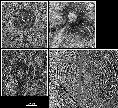
This is an image of four of the Europa craters, taken by the Galileo spacecraft. (Courtesy of NASA)
(56K JPG)

This image of Europa shows a dark feature. (Courtesy of NASA)
(56K JPG)
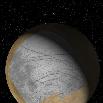
This is an image of Europa linea taken by the Galileo spacecraft. (Courtesy of NASA)
(56K JPG)

A global map of Europa. (Courtesy of NASA)
(56K JPG)
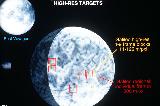
This drawing shows regions where pictures of Europa would be taken by the Galileo spacecraft. The spacecraft was not able to take detailed pictures of the entire surface. (Courtesy of JPL)
(56K JPG)

This is an image of Europa taken by the Galileo spacecraft. (Courtesy of NASA)
(56K JPG)
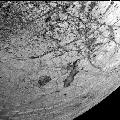
This is an image of Europa chaos regions taken by the Galileo spacecraft. (Courtesy of NASA)
(56K JPG)
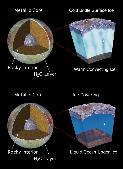
This is drawing of models of the interior of Europa. (Courtesy of NASA)
(56K JPG)

This drawing shows a model of the surface of Europa. (Courtesy of JPL)
(56K JPG)

This is drawing of a model of the interior of Europa. (Courtesy of NASA)
(56K JPG)
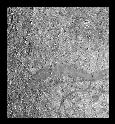
This is an image of mottled terrain taken by the Galileo spacecraft. (Courtesy of NASA)
(56K JPG)

This image shows "rafting" on the surface of Europa. (Courtesy of NASA)
(56K JPG)

This is an image of Europan ridges taken by the Galileo spacecraft. (Courtesy of NASA)
(56K JPG)

This is an image of Europan ridges taken by the Galileo spacecraft. (Courtesy of NASA)
(56K JPG)

This is an image of Europan ridges taken by the Galileo spacecraft. (Courtesy of NASA)
(56K JPG)

This image compares a Europan fault with the San Andreas fault in California. (Courtesy of NASA)
(56K JPG)
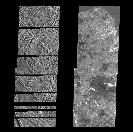
This image compares Europa with the San Francisco Bay. (Courtesy of NASA)
(56K JPG)
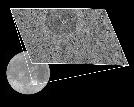
This is a close-up image of Europa taken by the Galileo spacecraft. (Courtesy of NASA)
(56K JPG)

This is a close-up image of Europa taken by the Galileo spacecraft. (Courtesy of NASA)
(88K JPG)
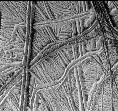
This is a close-up image of Europa taken by the Galileo spacecraft. (Courtesy of NASA)
(106K JPG)
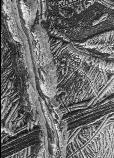
This is a close-up image of Europa taken by the Galileo spacecraft. (Courtesy of NASA)
(83K JPG)

This is a close-up image of Europa taken by the Galileo spacecraft. (Courtesy of NASA)
(77K JPG)

This is a close-up image of Europa taken by the Galileo spacecraft. (Courtesy of NASA)
(45K JPG)

This is a close-up image of Europa taken by the Galileo spacecraft. (Courtesy of NASA)
(62K JPG)
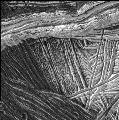
This is a close-up image of Europa taken by the Galileo spacecraft. (Courtesy of NASA)
(103K JPG)
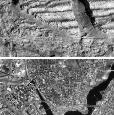
This is a close-up image of Europa taken by the Galileo spacecraft. (Courtesy of NASA)
(92K JPG)

This is a close-up image of Europa taken by the Galileo spacecraft. (Courtesy of NASA)
(45K JPG)

This is a close-up image of Europa taken by the Galileo spacecraft showing a giant fault. (Courtesy of NASA)
(45K JPG)

This is a close-up image of Europa taken by the Galileo spacecraft showing a giant fault. (Courtesy of NASA)
(45K JPG)
Ganymede

This is a natural-color image of Ganymede, Jupiter's largest satellite and is the third of the Galilean moons. (Courtesy of NASA)
(114K GIF)
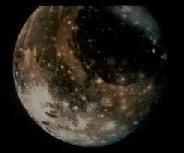
This is an image of Ganymede taken by Voyager showing the ancient "dark terrain". (Courtesy of NASA)
(60K JPG)

This is an image of Ganymede taken by Voyager showing what is called "grooved terrain". (Courtesy of NASA)
(60K JPG)

This is an image of Ganymede taken by Voyager showing what is called "grooved terrain". (Courtesy of NASA)
(60K JPG)

This is an image of Ganymede taken by Voyager showing what is called "light terrain". (Courtesy of NASA)
(60K JPG)
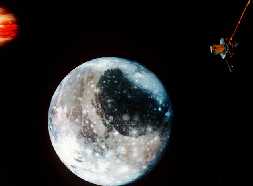
This is an image of Ganymede taken by Galileo. (Courtesy of NASA)
(60K JPG)
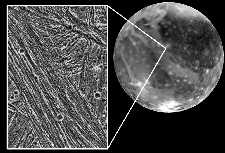
This is an image of Ganymede taken by Galileo. (Courtesy of NASA)
(60K JPG)
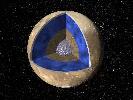
This drawing shows the possible interior of Ganymede. (Courtesy of JPL)
(60K JPG)
Callisto

This is a three-color filter image of Callisto, one of Jupiter's satellites taken by Voyager 2. The bright spots here are meteorite impact craters. (Courtesy of NASA)
(45K JPG)

This is a close-up image of Callisto taken by Voyager 1. (Courtesy of NASA)
(137K JPG)
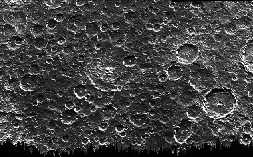
This is a three-color filter image of Callisto, one of Jupiter's satellites taken by Galileo. The bright spots here are meteorite impact craters. (Courtesy of NASA)
(45K JPG)

This drawing shows the possible interior of Callisto. (Courtesy of JPL)
(60K JPG)
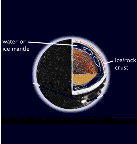
This drawing shows an old model of the possible interior of Callisto. It has been shown that Callisto has no core, nevertheless, as shown in the drawing, there may be currents circulating near the surface of Callisto. (Courtesy of The New Solar System.
)
(60K JPG)
The Atmosphere of Jupiter

This is an image of Jupiter's giant redspot. (Courtesy of NASA)
(71K JPG)

This is a false color image of Jupiter's redspot. (Courtesy of NASA)
(91K JPG)

This is another false color image of Jupiter's redspot. (Courtesy of NASA)
(98K JPG)

This is an image of the large brown oval on Jupiter. (Courtesy of NASA)
(66K JPG)

An image of Jupiter's atmosphere taken by the Galileo spacecraft. (Courtesy of NASA)
(45K JPG)

An image of Jupiter's atmosphere taken by the Galileo spacecraft. (Courtesy of NASA)
(45K JPG)

An image of Jupiter's Great Red Spot taken by the Galileo spacecraft. (Courtesy of NASA)
(45K JPG)
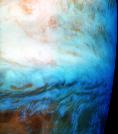
An image of Jupiter's atmosphere taken by the Galileo spacecraft. (Courtesy of NASA)
(45K JPG)
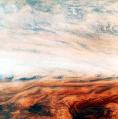
An image of Jupiter's atmosphere taken by the Galileo spacecraft. (Courtesy of NASA)
(45K JPG)

An image of Jupiter's atmosphere taken by the Galileo spacecraft. (Courtesy of NASA)
(45K JPG)

An image of Jupiter's atmosphere taken by the Galileo spacecraft. (Courtesy of NASA)
(45K JPG)

An image of Jupiter's atmosphere taken by the Galileo spacecraft. (Courtesy of NASA)
(45K JPG)

An image of Jupiter's white ovals taken by the Hubble telescope. (Courtesy of G. Orton and NASA)
(24K JPG)

An image of Jupiter's white ovals taken by the Hubble telescope. (Courtesy of G. Orton and NASA)
(18.0M TIFF)

This is an artists rendition of the formation of white ovals in Jupiter's atmosphere.
(Courtesy C. Alexander)
(23K GIF)
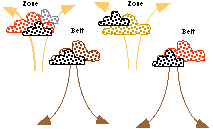
This is an artists rendition of belts and zones in Jupiter's atmosphere.
(Courtesy C. Alexander)
(23K GIF)

This is an artists rendition of belts and zones in Jupiter's atmosphere.
(Courtesy C. Alexander)
(23K GIF)

This drawing provides definitions of the different cloud forms of Jupiter.
(Courtesy NASA)
(83K JPG)
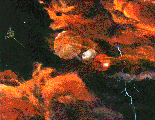
This is an artists rendition of the Galileo Probe parachuting into Jupiter's atmosphere. (Painting by Ken Hodges)
(83K JPG)

This is an artists rendition of the Galileo Probe parachuting into Jupiter's atmosphere. (Painting by Ken Hodges)
(83K JPG)
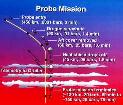
This is an artist rendition of the Galileo Probe parachuting into Jupiter's atmosphere. (Painting by Ken Hodges)
(83K JPG)
Jupiter's Magnetosphere

This drawing shows a portion of the front-side of the magnetosphere of Jupiter. (Courtesy of NASA)
(60K JPG)

This is an image of the magnetosphere of Jupiter in radio wavelengths rather than visible wavelengths. Jupiter emits a lot of radio waves, and can be "heard" with the proper radio receivers. (Courtesy of NASA)
(60K JPG)

This drawing shows a portion of the magnetosphere of Jupiter. (Courtesy of NASA)
(60K JPG)

This Io torus is part of the magnetosphere of Jupiter. The volcanism of the moon Io has a huge effect on the magnetosphere of Jupiter. (Courtesy of NASA)
(60K JPG)
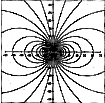
a.) Jupiter's magnetosphere is very different from that of other planets. This drawing shows an example of a simple dipole. (Courtesy of JPL)
(60K JPG)

b.) This drawing shows what the magnetosphere of Jupiter would be like if it were like a simple dipole. (Courtesy of JPL)
(60K JPG)

c.) This drawing shows the actual magnetosphere of Jupiter. It is very "pointy"; shaped somewhat like a torpedo. This is not like a simple dipole at all. (Courtesy of JPL)
(60K JPG)

This drawing shows a portion of the interior of the magnetosphere of Jupiter. (Courtesy of JPL)
(60K JPG)

This drawing shows a portion of the magnetosphere of Jupiter. (Courtesy of D. Williams, APL)
(60K JPG)

This drawing shows a portion of the magnetosphere of Jupiter interacting with Ganymede. (Courtesy of D. Williams, APL)
(60K JPG)

This drawing shows a comparison of the magnetospheres of Jupiter, Earth, and Jupiter's moon Ganymede. (Courtesy of D. Williams, APL)
(60K JPG)
Jupiter Aurora

An image of Jupiter's aurora taken by the Galileo spacecraft. (Courtesy of NASA)
(45K JPG)
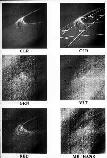
An image of Jupiter's aurora taken by the Galileo spacecraft. (Courtesy of NASA)
(45K JPG)
Go back to Mars , Pluto, Mercury, Saturn, Neptune, Venus , Moon , Earth, Asteroids, Comets, Sun , Missions, Uranus, Astrophysical Objects Mariner, Viking, Mars Pathfinder, Mars Global Surveyor






